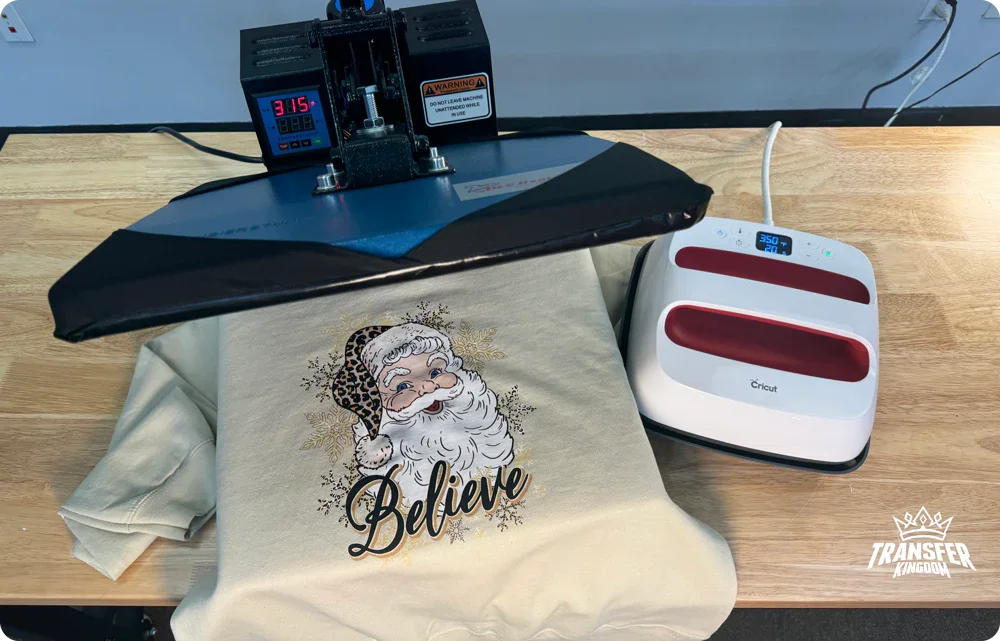Which is Better: Cricut EasyPress vs. Heat Press Machine?

Stuck between a Cricut EasyPress and a traditional heat press for your DTF transfers? You're not alone in this heated debate (pun intended!). As DTF printing gains popularity, choosing the right press has become crucial for crafters and businesses alike. Whether you're a weekend DIY-er or a full-time customization pro, getting those transfers to stick perfectly is key. Let's break down these two contenders and help you find your ideal DTF partner. Ready to press on?
Cricut EasyPress: Ideal for Convenience and Small Projects
The Cricut EasyPress has become a favorite among hobbyists and small-scale crafters due to its user-friendly features:
-
Pros:
- Compact and Portable: The Cricut EasyPress boasts a lightweight and compact design, making it ideal for limited workspaces or crafters on the go.
- Simple Operation: Featuring pre-set temperature and timer settings for various materials, the EasyPress eliminates the need for manual adjustments, simplifying the heat transfer process.
- Cost-Effective: Generally more affordable than professional heat presses, the EasyPress is a budget-friendly option for beginners or hobbyists.
- Safety Features: The smaller heating element and automatic shut-off features make the EasyPress a safer choice for home use compared to bulkier heat presses.
-
Cons:
- Limited Platen Size: The Cricut EasyPress comes in various sizes, but even the largest option might not accommodate very large DTF transfers commonly used in business settings.
- Pressure Limitations: The EasyPress offers lower pressure output compared to professional heat presses. This might affect transfer quality on thicker materials or require longer pressing times.
- Production Volume: Due to its size and pressure limitations, the EasyPress isn't ideal for high-volume production runs.
Traditional Heat Press: Powerhouse for Professional Results
For businesses and those working with larger DTF transfers, traditional heat presses offer distinct advantages:
-
Pros:
- Platen Size Options: Traditional heat presses come in a wider range of platen sizes, allowing you to accommodate various DTF transfer dimensions.
- Pressure Control: These presses offer greater control over pressure, ensuring high-quality transfers on different materials, especially thicker substrates.
- Faster Pressing: Traditional heat presses often have faster pressing times compared to the EasyPress, improving efficiency for high-volume production.
- Durable Construction: Built for frequent use, traditional heat presses boast a more robust construction, ideal for professional environments.
-
Cons:
- Footprint: Traditional heat presses require dedicated workspace due to their larger size.
- Learning Curve: Setting temperature and time settings manually requires a steeper learning curve compared to the EasyPress's pre-sets.
- Cost: Generally, traditional heat presses have a higher price point than the Cricut EasyPress.
- Portability: Their bulkier design makes them less portable, not suitable for those who need to take their heat press to craft fairs or workshops.
Choosing the Right Heat Press: A Side-by-Side Comparison
Here's a table summarizing the key features of Cricut EasyPress and traditional heat presses to help you visualize the differences:
|
Feature |
Cricut EasyPress |
Traditional Heat Press |
| Platen Size |
Limited |
Wide range of sizes |
| Pressure Output |
Lower |
High |
| Temperature Range |
up to 400° | up to 400°+ |
| Ease of Use |
Simple |
Manual settings |
| Portability |
High |
Low |
| Cost |
Affordable |
Generally higher cost |
Making an Informed Decision
The best heat press for you depends on your specific needs and budget. Consider the following factors:
- Business Needs and Budget: Evaluate your budget constraints and the volume of DTF transfers you typically produce.
- Transfer Size: Consider the typical size of your DTF transfers and choose a heat press with a platen that can accommodate them comfortably.
- Production Volume: High-volume production demands a heat press that can handle frequent use and faster pressing times.
- Portability Needs: If you travel for events or workshops, portability might be a crucial factor.
Conclusion
Both the Cricut EasyPress and traditional heat presses have their merits, catering to different needs in the heat transfer world. The Cricut EasyPress stands out for its user-friendliness, portability, and affordability, making it an excellent choice for hobbyists and small-scale projects. Traditional heat presses, with their larger platen sizes, higher pressure output, and faster pressing times, are better suited for professional settings and high-volume production. Your choice should ultimately depend on your specific requirements, considering factors such as project types, workspace, budget, and long-term goals. Whether you opt for the versatile Cricut EasyPress or the robust traditional heat press, both tools can effectively bring your creative visions to life in heat transfer projects.





